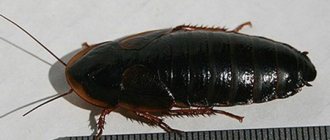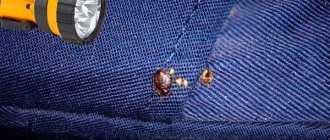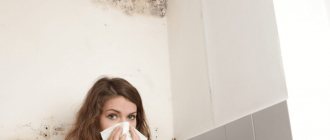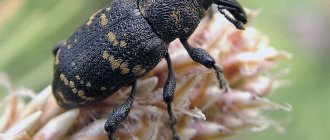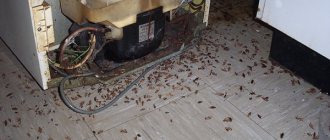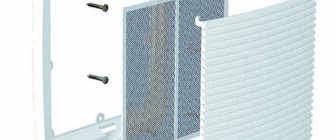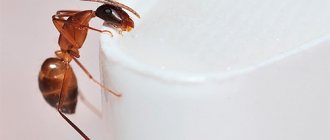A variety of insects often settle in the vicinity of humans, which sometimes cause inconvenience. Some of them are completely harmless to people and animals, while some, on the contrary, are extremely dangerous parasites. One of these insects are hay eaters, or as they are also called “book lice.” They are quite rare insects. However, their appearance in an apartment or house can bring a lot of negative emotions and harm to a person.
An invasion of hay beetles is an unpleasant “surprise” for home owners. After all, they may not even know where these insects came from. In any case, everyone wants to get rid of book lice as quickly as possible so that they do not bother them. We will tell you in what ways this can be done in this article.
Description of hay beetles, their eating habits and reasons for their appearance in the home
Hay eaters are widespread in the wild. This is their natural habitat. Bugs live in grass, bushes and trees. This type of insect can feed on plant foods and sometimes the remains of dead animals.
Book lice differ from ordinary lice in many ways. The size of domestic hay beetles is 2 millimeters, while the size of other lice and bedbugs is 4-6 millimeters. The color of hay eaters can vary from pale white to dirty yellow. These insects do not bite people or pets, whereas regular lice do so for their nutrition.
When settling in apartments, book lice feed on paste. It is because of this that their name actually arose. Previously, back in Soviet times, book spines were used to prepare paste. That is why hay eaters can often be found between the pages of old books.
Today, such pastes are no longer produced and therefore book lice do not live in all books. They live only in libraries or in the homes of people who collect old publications. Despite this, this type of insect easily adapts to any conditions of residential apartments and houses, finding food for itself there.
Senoyeds can also be found in the so-called “Stalinka” buildings. The fact is that in such houses there are traces of wallpaper glue, which these insects love so much. In addition, fungus is common in “Stalinkas”, which serves as a favorable condition for the proliferation of lice. In addition to mold and paste, hay beetles can also feed on other remains of organic elements. Their rapid reproduction is also influenced by warm air in the room and increased humidity levels.
In many cases, book lice choose as victims the owners of the upper floors, as well as the owners of private houses with leaking roofs.
Species characteristics of the pest
The order of hay eaters has more than five thousand species. These are small bugs about 1 mm in size, the largest types are no more than 5 mm. The pest is easy to distinguish by its unique head structure:
- The massive upper jaw is typical of chewers.
- On the bottom there is a hard process directed forward with teeth.
- It looks like a small proboscis.
- The beetle uses it to break and crush food.
- The body is oval, flat.
Most species have wings or vestigial remains of them. Despite this, pests rarely fly, but move very quickly. In nature, they live in warm, humid places: in forests, meadows, and swamps.
They feed on plant dust, parasitic and mold fungi, plant debris, and tiny organisms. They are unpretentious in food, so they find food everywhere.
Two types of pests are dangerous for residents of our country: book lice and dusty hay beetles. They are not much different from each other, only the latter can fly. They start in damp, warm corners: bathrooms or toilets.
They love new buildings, especially block ones, for their high humidity and the opportunity to use casein glue, tile grout, etc. In the kitchen they prefer cabinets with cereals and flour and other supplies.
Books are especially attractive to harmful insects. Previously, paste was used to make bindings, which they love very much. Therefore, colonies of bugs live in any book depository or library. They are brought into the house along with books.
This is not the only way book lice appear in an apartment. They are brought with contaminated cereals or flour or other products.
Pests enter a home through ventilation shafts, small gaps between the wall and a window or doorway, or even the smallest crack. They settle in secluded places, preferring the most humid ones. The presence of mold provides them with a food supply. You need to start fighting them immediately after at least one individual has been spotted.
You need to understand that the bugs are small. Most often, when they catch your eye, their numbers are already very large.
Specifics of the appearance of hay beetles in apartments and houses
Often insects such as book lice settle in the pipes of the garbage disposal and heating system. In an apartment or house, they can sit comfortably in the kitchen cupboard, eating dry cereals and pasta. It is also worth remembering that if you have old Soviet-era literature at home, then in 95% of cases these insects have already made it their refuge.
It is surprising and at the same time scary that book lice can produce offspring without direct fertilization. Their females can lay from 25 to 60 eggs during the day.
It is for this reason that owners of houses and apartments must keep their homes clean. After all, dirt, dust, and crumbs contribute to the appearance of hay beetles and their rapid reproduction.
What are the main characteristics of the appearance of the hay beetle?
This creature has the following structural features:
- Small sizes. The size of these pests on average does not exceed 1-1.5 mm, so they can enter the home through almost any opening.
- Lack of wings. Hay eaters either do not have wings at all, or have them in their infancy
- Flattened body. As can be seen in the photo of hay beetles, the book louse has a flattened body, expanded downwards. Dust louse – uniform and slightly convex.
- Yellowish-brown color. The color of the insect can vary from yellow-brown to red-brown.
- Long mustache. This is one of the distinctive features of the hay beetle; in dust louse they have a segmented structure.
The hay beetle runs quickly and leaves behind waste products. They like to settle in new buildings, damp rooms, and can enter the house with books contaminated with food or naturally. The pest goes through an incomplete life cycle and stops at the imago stage - an underdeveloped adult insect with a translucent body.
In this video you can see what hay eaters look like in an apartment:
Peculiarities of book lice reproduction
Hay eaters can lay either 1 or several eggs at a time. On average, they produce up to 40 eggs in one day. The maximum number they can lay in 24 hours is 60 eggs.
Almost all eggs hatch into larvae in 99% of cases. The lifespan of an adult is related to its habitat: temperature, humidity and food availability. In the right conditions, healthy insects can live up to 53 weeks. However, even if there is no food, hay beetles can live indoors for quite a long time without it.
Answers to popular questions
The hay beetle is an insect that prefers tropical and subtropical climates. His stay in our latitudes is accompanied by a lot of questions. Answers to some of them are given below.
What does an insect eat?
Hay eaters are quite unpretentious eaters.
For food, bugs use:
- Organic remains.
- Mold fungi.
- Lichens.
- Rotten stumps and trees.
- Green algae.
Having settled in a living space, the bugs can easily find something to eat:
- Food supplies (such as cereals or pasta).
- Carpet covering.
- Furniture.
The abundance of food and favorable conditions contribute to uncontrolled reproduction.
Do book lice jump?
The absence of wings does not create obstacles for the book louse. Hay eaters are not capable of jumping, but the speed of their movement is the envy of many insects.
Beetles often group in numerous colonies, although they can exist in small groups and individually. If a group of pests begins to move from place to place, this process is accompanied by a characteristic chirping sound.
What is the danger of insects to humans?
Being a pest, the insect only spoils things and products without posing a threat to humans. However, if there are old books or a herbarium in the apartment, there is still no point in postponing disinfestation.
The presence of bugs is confirmed by traces of their vital activity (excrement, scales after molting, etc.).
Important: food products “labeled” in this way are unsuitable for use, as they can provoke allergic reactions
Reasons for appearance
Hay eaters feel most comfortable at a temperature of 25–35°C and an air humidity of 75% or higher. However, often when these indicators decrease, insects are in no hurry to leave their habitable places. The reason for this is due to additional factors that deter insects.
Hay eaters are attracted not only by dampness, but also by the mold on which they feed. A flooded basement or leaking roof can be the cause of an infestation of hay beetles on the first and last floors.
Defects in waterproofing, obvious or hidden leaks in pipes, ceilings, closed structures - all these are possible causes. High humidity and, as a result, mold are also almost always present in corner apartments. Sometimes seam joints in panel houses allow moisture to pass through, be it rain or snow. The formation of mold behind the wallpaper may not yet be noticeable, but this is already enough for hay beetles to appear.
Sometimes hay eaters move into new houses that have not yet been put into operation. They are attracted to casein glue, tile grout, paste and other tasty materials. In addition, new buildings have not yet been dried out after construction work, and residents have not yet had time to pollute the atmosphere with various household chemicals.
In old houses, the cause of hay beetles may be natural wallpaper pasted with paste. Insects love starch and any of its compounds.
Book lice got their name precisely because of their addiction to the paste that used to be used to glue the pages of books. Therefore, if there is a library in the house containing books from old publications, this may be the reason for the appearance of hay beetles.
- Insects are also attracted to dust. Very often they start up and actively reproduce in various archives and storage facilities with documentation, in museums and library branches with old stale literature.
- In the second half of the last century, in the book printing industry, casein glue was completely replaced by synthetic glue, which is of no interest to hay eaters. And therefore, books of later editions, kept clean, are not at all interesting to insects.
- The dust louse, unlike the book louse, gravitates more towards the kitchen, and not towards “knowledge”. For her, the best shelter and food will be the stocks of cereals in the pantries.
- There are known cases where large grain storage facilities were contaminated with hay beetles and their metabolic products. In this regard, the procurement industry of agriculture has developed a number of instructions and rules for the storage of grain, raw materials and products, prevention and control of pests at elevators and grain receiving enterprises.
Feeding on the remains of plant and animal origin, hay beetles can also be found in herbariums, entomological and zoological collections. Especially if these collections are maintained without proper care.
- Another reason for the appearance of hay beetles may be indoor plants, especially those that require frequent watering. High humidity and fungal spores for nutrition are ideal conditions for the development and reproduction of insects.
You can recognize the presence of hay beetles in a room by the quiet ticking sound produced by large clusters of insects. At night, when everything around is quiet, this sound is heard especially clearly.
Reproduction method
- The book louse develops through 3 stages of hemimetamorphosis: egg, larva and imago (mature individual). It reproduces by parthenogenesis (without prior fertilization).
- The female can bear offspring 5-6 times a year. She lays 40-60 eggs per day on hard surfaces and covers the clutches with rectal secretions. After 10-12 days, the eggs hatch into larvae. It takes nymphs 21 to 28 days to reach the adult stage.
- The rate of maturation depends on temperature and humidity. The higher they are, the faster the parasite grows. Under favorable conditions, 75-80% of the offspring survive. And after a month, new adults are ready to reproduce.
- Troctes divinatorius live on average 45 to 50 weeks, and females can lay eggs throughout their lives. Even a single masonry can infect large areas of premises. Therefore, it is important to get rid of hay beetles as soon as they appear.
Key dangers of book lice
The main danger of hay beetles for human health is the occurrence of an allergic reaction of varying severity from touching the insect or from contact with the place where it has been.
In many cases, such allergic manifestations are not dangerous for people and are usually mild. However, sometimes without proper assistance, a person may develop Quincke's edema, which threatens to suffocate.
Sometimes hay eaters can scare children and even adults. For some who suffer from entomophobia (fear of insects), lice can cause serious inconvenience and problems.
As a rule, the population of England, as well as some other European countries, suffers from book lice.
Prevention methods with hay eaters
The dilemma of how to exterminate hay beetles is familiar to residents of Russia. However, fortunately, this problem is not as widespread in our country as, for example, in the UK. Therefore, there are no special methods to combat hay beetles. However, there are tips and tricks to help remove these harmful bugs:
- You should pay special attention to cleanliness and hygiene in your apartment or house - wash the floors every day, wipe the dust off the bookshelves, take out the trash every day.
- If there are flowers and herbariums in the house, it is recommended to frequently wipe off the dust from them.
- It is better not to store old cereals and expired food in the kitchen. They need to be thrown into the trash so that they do not become a source of food for hay eaters.
If there are a lot of book lice in your home, only heavy artillery will help. For example, disinfection of premises, which is carried out using special chemical poisons. Special services can effectively deal with insects using insecticidal preparations. In very advanced cases, treatment with cold or hot fog will help, which will cover the entire area of the apartment or house.
What chemicals are used
It is very difficult to get rid of hay eaters in an apartment. It is necessary to constantly monitor the microclimate in the room, since treatment with insecticides gives only temporary results. If prevention does not help, and a pest has infested the premises, then treatment with special chemicals should be carried out.
It must be carried out by a specially trained person who can correctly calculate the dosage of the drug and treat the room.
To destroy the pest, insecticides such as Executioner, Cucaracha, Akarin, Flitsid are most often used.
In what cases is it necessary to destroy book lice?
In some cases, it does not make sense to treat premises against hay eaters. After all, they are not dangerous to people and animals, do not carry infections, do not bite and do not live in upholstered furniture or bedding, and do not even have a specific smell.
The only thing they can do is scare a person or cause allergies, eat cereals and leftover food, and also spoil book publications.
We can safely say that book lice do not pose a serious danger to humans and their homes. Whether to exterminate them or not is a matter of choice. This issue is decided based on the number of insects and the problems that home owners have because of them.
The book that was ruined by the hay eaters
Folk and chemical methods of exterminating hay eaters
If hay eaters have found refuge in the form of books or things, you can use folk methods of combating these insects:
- Books and any other paper items infested with book lice can be placed in the freezer for 24 hours. It is recommended to first wrap the paper item in a plastic bag. It is not recommended to do this with valuable books and other antique items.
- It is better to wash clothes and textile items with traces of the presence of book lice at maximum temperature. Next they are treated with a steam iron or just an iron.
If the item cannot be washed at high water temperatures, you can add the following chemicals to the washing machine: “Abacteril”, “Forex-Chlor”, “Trilox”, “Purzhavel”, “A-Par”.
Insecticidal preparations for controlling hay beetles at home
If you decide to destroy book lice in your home yourself, the following insecticidal preparations for crawling insects are ideal for this purpose:
- “Clean House Super” is universal;
- “Raptor” is universal;
- “Combat Multispray;
- "Raid";
- “Destructive power maximum 5 in 1”;
- “Varan.”
If hay beetles have settled in books, you can try to treat the book publications themselves with poison. However, in this case you need to take some precautions:
- Take any old or unwanted piece of paper and apply the product to it;
- After a few minutes, see if the product leaves visible marks on the paper covering;
- If you find no traces, then you can safely use the product for books and paper items.
However, to use this method, you must follow the following algorithm:
- Lay oilcloth or plastic film in the place where you will be processing.
- Arrange the books so that they are open and stand as they would on a shelf.
- Spray the product from above, 50 centimeters from the books.
- Wait until the product settles on the pages, spine and cover of the books.
- Leave books open for 24 hours.
- After time has passed, treat the shelf on which the books were located and put them back.
- Do not allow direct sunlight to hit the pages of books or other parts of them.
This procedure almost always destroys insects. But it does not guarantee that books and other paper products will remain in order after processing.
Before using any product against book lice, carefully read the instructions for use of the product. Remember that you need to find out what objects and surfaces you can use the product on. Remember to wear safety glasses, gloves and a respirator before you begin processing.
If hay beetles are infested in the kitchen, you need to throw away all food and leftover food that may have harbored lice. Next, all shelves and cabinets in the kitchen are treated with the selected insecticide, as well as the entire room.

